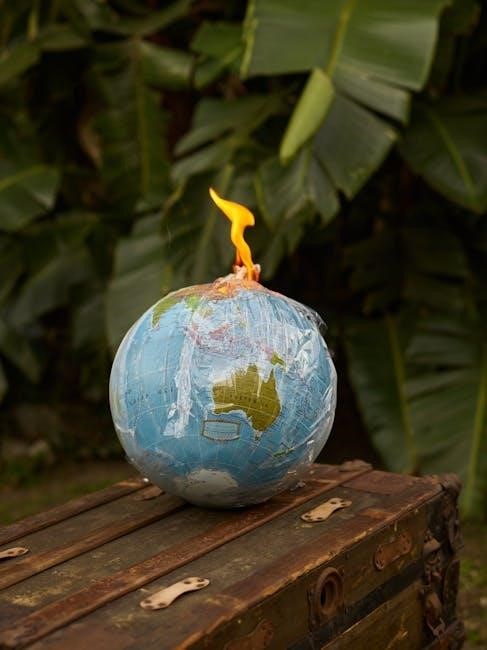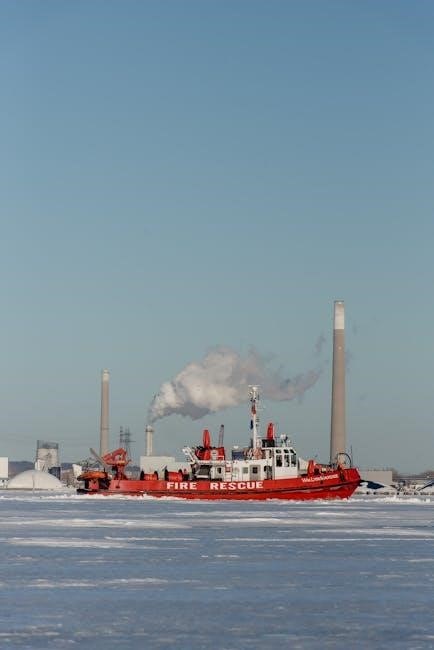The World of Ice and Fire is a companion guide to George R.R. Martin’s epic A Song of Ice and Fire series, offering a deep dive into its rich lore. This is a work of fiction, where names, characters, and incidents are products of the author’s imagination, blending history, culture, and magic to create a captivating universe. The book serves as an essential resource for fans, exploring the geopolitical and cultural tapestry of Westeros and Essos.
Overview of the Book and Its Significance
The World of Ice and Fire is a meticulously crafted companion guide to George R.R. Martin’s A Song of Ice and Fire series, offering an in-depth exploration of its sprawling universe. This comprehensive volume delves into the history, cultures, and geography of Westeros and Essos, providing fans with a richer understanding of the series’ intricate world-building. It serves as both a reference for dedicated fans and a gateway for newcomers, bridging the gap between the novels and the Game of Thrones adaptation. The book’s significance lies in its ability to immerse readers in the lore, making it an essential resource for anyone captivated by Martin’s epic saga.
The Author’s Vision and Creative Process
George R.R. Martin, alongside co-authors Elio M. García Jr. and Linda Antonsson, crafted The World of Ice and Fire to expand the lore of Westeros and Essos. Martin’s vision was to create a comprehensive guide that delves into the history, cultures, and legends of his sprawling universe. The book reflects his meticulous world-building, blending historical accuracy with fantastical elements. This collaborative effort captures the essence of Martin’s creative process, offering fans a deeper understanding of the series’ intricate tapestry. It serves as a testament to his dedication to crafting a rich, immersive world.
Key Themes Explored in The World of Ice and Fire
The book explores themes of power, loyalty, betrayal, and moral ambiguity, shaping the intricate political and social landscapes of Westeros and Essos.
The Struggle for Power and Its Consequences
The struggle for power is a central theme, driving the intricate political dynamics of Westeros. Ambition and greed often lead to devastating conflicts, reshaping kingdoms and legacies. The rise and fall of dynasties, such as the Targaryens, illustrate the volatile nature of power, where even the mightiest can crumble. Betrayals and alliances forged in pursuit of the Iron Throne highlight the moral costs of rulership. This relentless pursuit of dominance not only shapes the fate of individuals but also the future of entire realms, leaving lasting scars on the world of ice and fire;
Loyalty, Betrayal, and Moral Ambiguity
Loyalty and betrayal are woven into the fabric of Westeros, shaping the fates of characters and kingdoms. The binds of duty and honor often clash with personal desires, leading to morally complex decisions. Figures like Jon Snow embody unwavering loyalty, while others, such as Littlefinger, master the art of betrayal. Moral ambiguity reigns supreme, as even noble actions can have dire consequences. This duality creates a rich tapestry, where characters must navigate a world where right and wrong are seldom clear-cut, making their choices both poignant and far-reaching in the struggle for survival and power.

Notable Characters in The World of Ice and Fire
The book highlights iconic figures like Daenerys Targaryen, Jon Snow, and Tyrion Lannister, whose complex journeys shape the story of Westeros and Essos, blending power, honor, and wisdom.
Daenerys Targaryen and Her Dragons
Daenerys Targaryen, the exiled princess of House Targaryen, emerges as a central figure in The World of Ice and Fire. Her journey from a timid bride to a powerful leader is marked by her unique bond with her dragons—Drogon, Rhaegal, and Viserion. These creatures, born from magic and fire, symbolize her destiny and the resurgence of Targaryen power. Daenerys’s vision of reclaiming the Iron Throne and her role as a liberator of slaves and oppressed peoples are deeply intertwined with her dragons, who embody both her strength and vulnerability in a world torn by conflict and ancient prophecies.
Jon Snow and the Night’s Watch
Jon Snow, the bastard son of Eddard Stark, becomes a pivotal figure in The World of Ice and Fire. His journey from an outcast to the Lord Commander of the Night’s Watch highlights his unwavering dedication to duty and honor. The Night’s Watch, sworn to protect the realm beyond the Wall, faces existential threats from the White Walkers. Jon’s leadership and sacrifices, including his death and resurrection, underscore his critical role in the Great War. His true identity as Aegon Targaryen adds layers to his destiny, intertwining his fate with the survival of Westeros and the Night’s Watch’s ancient mission.
Tyrion Lannister: The Politics of Wit and Wisdom
Tyrion Lannister, the witty and wise Imp, navigates the treacherous world of Westeros through intellect and cunning. Despite his physical limitations, he proves himself a master strategist, serving as Hand of the Queen to Daenerys Targaryen. His sharp tongue and ability to manipulate situations often save him from peril. Tyrion’s journey highlights the power of knowledge and wit over brute strength, making him one of the most compelling figures in The World of Ice and Fire. His moral ambiguity and loyalty to those he cares for define his complex character, shaping the fate of the realm.

The World of Westeros and Essos
Westeros and Essos are two continents in George R.R. Martin’s A Song of Ice and Fire, each with unique cultures, histories, and landscapes. Their diverse regions shape the story’s epic conflicts and alliances, creating a vast and immersive world for readers to explore.
Geographical and Cultural Diversity
The world of Westeros and Essos is marked by vast geographical and cultural diversity, shaping the intricate dynamics of its inhabitants. From the frozen tundras of the North to the scorching deserts of Essos, each region boasts unique landscapes and climates. The Seven Kingdoms of Westeros are divided into distinct areas, such as the Iron Islands, the Reach, and the Riverlands, each with its own traditions and values. Across the Narrow Sea, Essos is home to sprawling cities like Meereen, Yunkai, and Braavos, where diverse cultures and languages thrive. This diversity fosters both cooperation and conflict, enriching the tapestry of Martin’s world.
The Role of Magic and Mythology
Magic and mythology are integral to the world of Westeros and Essos, shaping its history and societies. From the ancient spells of the Children of the Forest to the dragonlords of Valyria, mysticism permeates the land. The White Walkers and their dark magic threaten the living, while the Lord of Light inspires followers with divine fire. Dragons, though rare, embody awe-inspiring power, symbolizing both destruction and hope. These elements weave a tapestry of wonder and fear, defining the world’s identity and influencing its conflicts. Magic here is both a force of creation and a source of chaos, shaping the destiny of its inhabitants.
Historical Events Shaping the Story
The Doom of Valyria, the Targaryen dynasty’s rise and fall, and the Night King’s origins shape the world’s history, influencing its conflicts and power struggles deeply.
The Doom of Valyria and Its Legacy
The Doom of Valyria was a cataclysmic event that shattered the Valyrian Freehold, a dominant world power, due to volcanic eruptions and magical cataclysms. This disaster led to the collapse of their empire, scattering its people and ending their mastery of dragons and magic. Survivors, like the Targaryens, fled to new lands, carrying remnants of Valyrian culture and power. The Doom reshaped global politics, creating power vacuums and influencing the rise of new dynasties. Its legacy is felt in the lingering magic, lost knowledge, and the enduring impact on the world of Westeros and Essos.
The Rise and Fall of the Targaryen Dynasty
The Targaryen dynasty, founded by Aegon the Conqueror, rose to power through their mastery of dragons and strategic alliances. Their rule was marked by both wisdom and turmoil, with dragons serving as symbols of their authority. However, internal conflicts, such as the devastating Dance of the Dragons, weakened the dynasty. The gradual decline of their dragon population and political instability led to their eventual fall. Despite their end, the Targaryens left a lasting legacy, shaping the history of Westeros and Essos through their conquests, traditions, and the enduring legend of their dragons.

The Night King and the Great War
The Night King, an ancient being of ice, leads the White Walkers in a relentless march to erase life from Westeros, sparking the Great War for survival.
The Threat of the White Walkers
The White Walkers, ancient beings from the First Long Night, seek to spread eternal darkness and destroy life in Westeros. Their army of the dead, led by the Night King, threatens to engulf the realm. With their icy powers and ability to raise the dead, they pose an existential danger to humanity. The Night King, wielding control over ice and death, is the embodiment of this threat. His return signals the end of an age, forcing the living to unite against a common enemy to survive the impending winter and the Great War that looms.
The Battle for the Iron Throne and the Living
The battle for the Iron Throne represents a clash of ambitions, alliances, and survival amidst the looming threat of the Great War. While the living grapple for power, the Night King’s army approaches, threatening to erase all life. Key players like Cersei Lannister, Daenerys Targaryen, and Jon Snow must navigate political intrigue and existential peril. The Iron Throne’s fate intertwines with the survival of Westeros, as the living must unite to face the White Walkers. This dual struggle defines the essence of The World of Ice and Fire, where power and survival are inextricably linked.
The World of Ice and Fire concludes the epic saga, leaving a lasting legacy in literature and media. Its rich storytelling and intricate world-building continue to inspire global audiences, influencing TV, films, and books. The series’ cultural impact is undeniable, shaping modern fantasy and captivating millions worldwide with its timeless themes of power, loyalty, and survival;
The Legacy of The World of Ice and Fire
The World of Ice and Fire has cemented its legacy as a defining work in modern fantasy, shaping literature, TV, and film. Its detailed world-building and complex characters have inspired countless adaptations, fostering a global fanbase. The book’s influence extends beyond entertainment, impacting cultural discussions and creative industries. As a companion to A Song of Ice and Fire, it remains a vital resource for exploring the series’ lore, ensuring its timeless appeal. Its impact continues to resonate, solidifying its place as a cornerstone of contemporary storytelling and a testament to George R.R. Martin’s visionary craft.
Its Influence on Literature and Media
The World of Ice and Fire has profoundly influenced literature and media, redefining epic fantasy. Its detailed world-building and complex characters have inspired authors and creators globally. The book’s success paved the way for Game of Thrones, a cultural phenomenon that reshaped television and pop culture. It also sparked a wave of fantasy adaptations, setting a new standard for depth and complexity in storytelling. Beyond literature, its impact is seen in video games, comics, and film, solidifying its role as a benchmark for immersive world-building and compelling narratives, leaving a lasting legacy in modern entertainment and storytelling.
